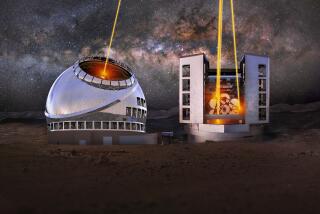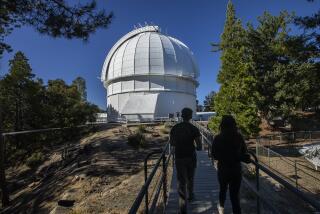Glass that changed the world
- Share via
CHICAGO — Like cellphones or the Internet, the telescope had a swift and lasting impact on the world.
Introduced in the early 17th century, telescopes revolutionized military strategy and inspired the father of astronomy, Galileo Galilei, who determined that Earth is not the center of the universe.
Until recently, scholars thought no more than 10 of these early telescopes -- made between 1608 and 1650 from tightly rolled paper and crudely ground lenses -- had survived.
Then two Chicago historians on a visit to Germany had an “aha!” moment. One of the oldest known surviving telescopes at a Berlin museum gave them an idea of where to look for other undiscovered examples.
Their insight apparently was correct. According to Marvin Bolt of the Adler Planetarium in Chicago, he and his colleague found a previously unreported 1627 telescope in a Dresden museum’s storage room within 24 hours of their brainstorm. Less than a day later, they found a second, slightly older telescope that had lain unnoticed in storage at a Kassel museum.
“This discovery is exciting because it suggests further places to look for more old telescopes,” said Bolt, who made the find with Chicago native Michael Korey, now a museum conservator in Germany.
Finding more early telescopes will help scientists and historians better understand who made them and how they improved over time, said M. Eugene Rudd, an emeritus professor of physics at the University of Nebraska and a world authority on old telescopes.
“I’ve seen the photographs of the two Marvin has located in Germany, and they certainly have the characteristics of the very early ones,” Rudd said. “I know of only eight telescopes that date before 1650 that still survive, so to find two more is extraordinary.”
Bolt is a technology historian at the Adler, which boasts the largest and finest collection of old scientific instruments in the Western Hemisphere, including an exquisite leather-covered, trumpet-shaped telescope made in Italy around 1630.
Korey is a conservator at the Mathematisch-Physikalischer Salon in Dresden. The museum has one of the world’s oldest and most renowned collections of historic scientific instruments.
Through an American Assn. of Museums program sponsored by the U.S. State Department, Korey visited the Adler collection last summer, working in areas in which Bolt lacks expertise. Then, in late September, Bolt flew to Dresden to help Korey with his museum’s collection of late-17th century and 18th century telescopes.
“I also wanted to visit some other museums that have the really old telescopes, hoping I might learn some things that might tell me more about our old telescope,” Bolt said. “We know very little about it.”
On Oct. 2, he and Korey visited Berlin’s Museum of Decorative Arts to see a well known telescope dating to 1617. It had been part of a collection of 17th century scientific instruments found in a finely crafted cabinet built for a royal family to display scientific instruments.
Such cabinets -- known as kunstschrank -- were status symbols in wealthy 17th century households. The idea was that, by owning a kunstschrank and its contents, the owners showed they were learned and knowledgeable as well as generous sponsors of scientists and their work.
When he saw the 1617 telescope and the elaborate cabinet it came from, Bolt said, a bell went off in his head: Other old cabinets scattered around Europe probably held old telescopes too.
“In a decorative arts museum, curators aren’t aware of the history of telescopes,” he said. “And if they have one belonging to one of these cabinets, they regard it more as a beautiful object rather than an example of early technology. On the other hand, I don’t think any technology historians had ever thought of a decorative arts museum as a place to hunt for early telescopes.”
He and Korey discussed canvassing museums that might own the cabinets. That night, while attending the opera in Dresden, Korey noticed a poster advertising the loan of a 17th century kunstschrank from Dresden’s decorative arts museum to a Budapest museum.
The next morning, Korey and Bolt visited the Dresden museum that had loaned out the cabinet. Why yes, the director said, an artifact that had been inside the cabinet might have been a looking device, but it was in such poor shape that it was not being displayed.
“In an early inventory of the cabinet’s contents, it simply listed a ‘perspective glass,’ ” not a telescope, Korey said.
Under Bolt’s guidance, a technician at Korey’s museum took the paper-tube telescope apart and found the lenses wadded up in balls of paper. Bolt spent until 1:30 the next morning examining the glass and the grinding techniques to estimate their age.
“Michael knew the year of construction of the cabinet the telescope came out of, but he wouldn’t tell me, as a sort of double-blind test of how accurate my age estimate might be,” Bolt said. “I finally guessed the lenses dated to the 1620s or the 1630s.”
The cabinet is positively dated to 1627.
At 5 that morning, he and Korey boarded a train for a Kassel museum devoted to scientific instruments, including many old telescopes, though none that were thought to predate 1650. It was Bolt’s last full working day in Germany before returning home, and he wanted to study several unusual telescopes there.
“About midafternoon, I mentioned what I had seen the night before and characteristics of really early ones,” Bolt said. “One of the curators said he thought they had something like that in storage, and they took me there to show it to me.
“There it was on the shelf -- a beautiful early one, dating around the 1630s, in much better shape than the one in Dresden. It had decorative gold fleur-de-lis tooling on the leather covering of the barrel, suggesting it was Italian or French-made.”
Bolt will return to Germany for more research next year.
Nobody knows who invented the telescope, but an obscure Dutch spectacle maker, Hans Lipperhey, is generally credited with demonstrating the first working model, at the court of Prince Maurice in the Netherlands in September 1608.
It was the middle of the savage Eighty Years’ War. Maurice and his realm were in the Protestant camp that fought throughout Europe against Roman Catholic partisans led by Spain. Lipperhey’s telescope caused a sensation; Maurice and his advisors saw it as a miraculous military tool to spy on enemy troops from long distances.
Unfortunately, Maurice talked so freely about the astounding new technology that the Spanish found somebody to build working telescopes almost immediately. Lipperhey never got the royal patent he had been seeking.
“The telescope is one of those revolutionary ideas that spread like wildfire,” Bolt said. “Just months after Lipperhey showed off his device, you could buy telescopes in Paris.”
Galileo read descriptions of telescopes, then built his own. By the end of 1609, he had examined the night skies and discovered that other planets had moons. That news eventually destroyed dogma holding that the rest of the universe rotated around Earth. Humans began to see that they lived in a tiny corner of a vast cosmos rather than at the center of things.
More to Read
Sign up for Essential California
The most important California stories and recommendations in your inbox every morning.
You may occasionally receive promotional content from the Los Angeles Times.










